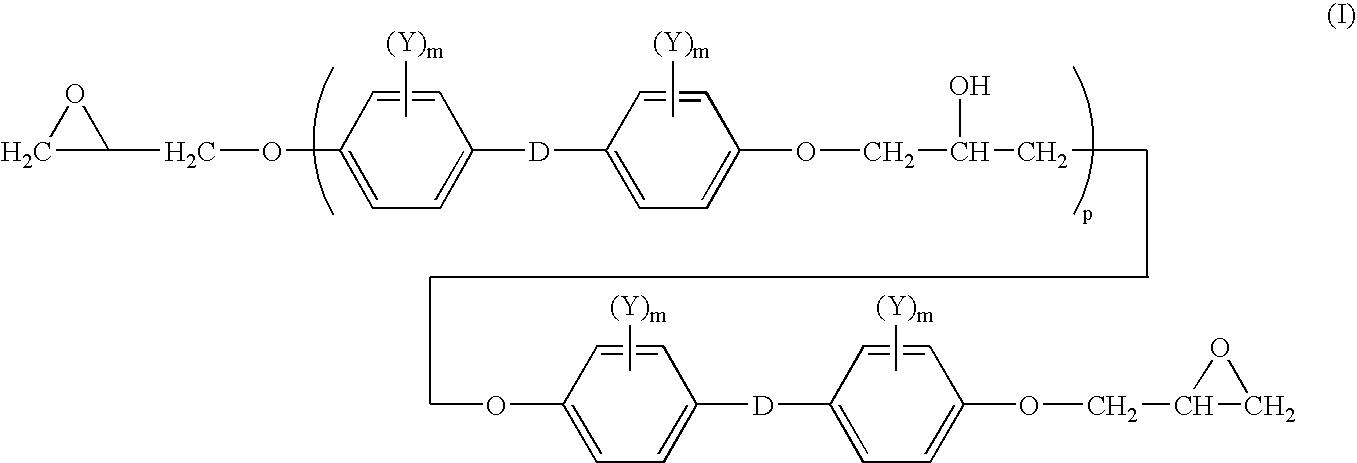Process for Preparing Composites Using Epoxy Resin Formulations
a technology of epoxy resin and composites, applied in the field of composite preparation using epoxy resin formulations, can solve the problems of increased overhead costs, increased manufacturing costs, increased maintenance costs, etc., and achieves the effects of reducing weight, reducing noise and vibration transmission, and reducing maintenance costs
- Summary
- Abstract
- Description
- Claims
- Application Information
AI Technical Summary
Benefits of technology
Problems solved by technology
Method used
Image
Examples
example 1
[0078]100 parts of diglycidyl ether of bisphenol A, corresponding to structure I above in which n is about 0.15 and each m is zero, is blended with 3 parts of a grey pigment and 0.8 parts of an internal mold release agent. This mixture is charged to a resin tank and heated to 70° C. with stirring.
[0079]A mixture of 90 parts of bis-(4-aminocyclohexyl)methane and 10 parts of 2,4,6-tris(dimethylaminomethyl)phenol is charged to a tank and heated to 30° C. with stirring.
[0080]A 25 micron unsaturated polyester gel-coat (Oldopal-ortho / NPG 717-7838 from BÜFA) is manually sprayed onto the top side of a vented truck wind deflector mold and allowed to dry for about 2 minutes. A pre-formed fiber glass reinforcement mat having a weight of 450 g / m2 then positioned manually into the mold, and the mold is closed.
[0081]The epoxy resin mixture and the hardener are injected into the mold through a static mixer dispensing unit. Air is removed from upper side vents of the mold. The ratio of epoxy resin ...
example 2
[0084]In this example, a truck top-sleeper unit is formed in a reaction injection molding process. The A-side is a diglycidyl ether of bisphenol A as described in Example 1. This mixture is charged to a resin tank and heated to 70° C. with stirring. The B-side is a mixture of 90 parts of bis-(4-aminocyclohexyl)methane and 10 parts of 2,4,6-tris(dimethylaminomethyl)phenol, which is preheated to 30° C. with stirring.
[0085]Fiber glass reinforcement mats are positioned manually into a truck top-sleeper mold, and the mold is closed. The epoxy resin mixture and the hardener are injected into the mold using a RIM machine. The shot weight is about 35 kg. The top side of the filled mold is heated to 88° C., and the bottom side is heated to 84° C. Demold time is 23 minutes after end of pouring. The demolded parts exhibit little shrinkage and have excellent surface characteristics. Shore D hardness of the parts at demold is 84-87, which indicates complete crosslinking and good curing.
[0086]For...
PUM
| Property | Measurement | Unit |
|---|---|---|
| temperature | aaaaa | aaaaa |
| temperature | aaaaa | aaaaa |
| melting temperature | aaaaa | aaaaa |
Abstract
Description
Claims
Application Information
 Login to View More
Login to View More - R&D
- Intellectual Property
- Life Sciences
- Materials
- Tech Scout
- Unparalleled Data Quality
- Higher Quality Content
- 60% Fewer Hallucinations
Browse by: Latest US Patents, China's latest patents, Technical Efficacy Thesaurus, Application Domain, Technology Topic, Popular Technical Reports.
© 2025 PatSnap. All rights reserved.Legal|Privacy policy|Modern Slavery Act Transparency Statement|Sitemap|About US| Contact US: help@patsnap.com



